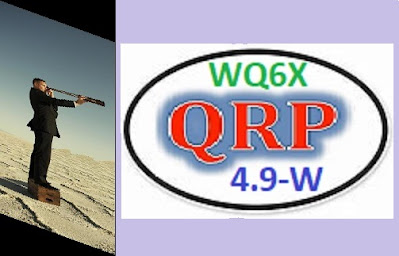I realized that a LoT of focus/attention has been put on QRP contest operations; in all honesty to create triple-OP operations, upping the overall contest ToTaL for 2022. It doesn't matter how we
GoT to QRP running, what matters is that we HAVE discovered the World of QRP and find it to
be substantially different, yet equally challenging than I contemplated before October of last year.
Putting the phrase "QRP" into the WQ6X Blog search engine, a LoT of Blog entries came up.
Chronologically we have the following Blog entries:
- [X] -1- WQ6X Triple-OP's yet another California QSO Party
- [X] -2- WQ6X Successfully Operates a 1st-time triple-OP Sweepstakes
- [X] -3- WQ6X works another dual-OP CQ WW Contest
- [X] -4- Some Thots on dual-OP'ing as QRP
- [X] -5- Triple-Thots about Triple-OP'ing the Ten-Meter Contest
- [X] -6- WQ6X reprises K6T for a 10-Meter triple-OP Operation
- [X] -7- WQ6X Wangles another Wonderfully ad-HOC Radiosport Weekend
- [X] -8- WQ6X Dual-OP's another ARRL RTTY Roundup (RU) Contest.
- [X] -9- QRP Reconsidered
- [X] -10- WQ6X Runs a 1st-ever NAQP QRP dual-OP Contest
- [X] -11- WQ6X dual-OPs a 1st NAQP Ssb GiG
Each of the above documented events provided a slightly different way to experience the QRP approach. As I said in the QRP reconsidered BLOG, successful operations happen ideally when
we run from a great QTH (high in elevation and relatively RFI-noise free), a super antenna system
(the WA6TQT location sports stacked Yagi's, and phased-vertical arrays), and run frequencies with plenty of QRM-free bandwidth on either side.
we run from a great QTH (high in elevation and relatively RFI-noise free), a super antenna system
(the WA6TQT location sports stacked Yagi's, and phased-vertical arrays), and run frequencies with plenty of QRM-free bandwidth on either side.
The main objective of this BLOG entry is to provide a simple landing page to accompany
my Saturday presentation on QRP for the Amateur Radio Club of Alameda (ARCA).
As club president, I am often called upon to give presentations on various topics, often
radiosport contest related. This talk will eventually be posted on YouTube. When that
happens, I will post a link to that video, here, in this BLOG entry.
my Saturday presentation on QRP for the Amateur Radio Club of Alameda (ARCA).
As club president, I am often called upon to give presentations on various topics, often
radiosport contest related. This talk will eventually be posted on YouTube. When that
happens, I will post a link to that video, here, in this BLOG entry.
Do YOU ever run QRP operations?
What has YOUR Experience been like?

.Jpg)
.Jpg)



.Jpg)





